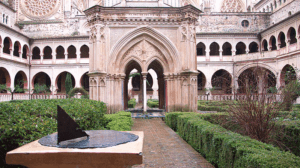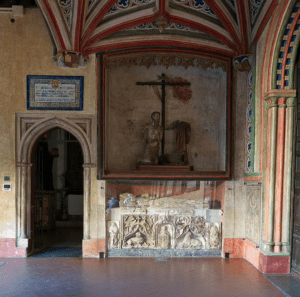Nicolás Roberto Robles
Badajoz, Spain
 |
| Figure 1. The Monastery of Guadalupe. Main entrance. Photo by Rafa G. Recuero. Via Wikimedia. CC BY-SA 3.0 ES. |
Guadalupe, a small Spanish town in the district of Cáceres, Extremadura, arose around a monastery. Legend says that a shepherd named Gil Cordero was looking for a stray sheep when the Virgin Mary appeared to him. When the shepherd told of this apparition, the clergymen of Cáceres went to the place and found a half-buried image of the Virgin that the Christians had hidden during the Arab invasions. To celebrate the event, the locals built a hermitage. In 1330 King Alfonso XI of Castille visited the area and ordered the construction of a monastery. When construction was completed in 1389, the monastery was taken over by the friars of the Order of St. Jerome.
One of the duties of the Hieronymite monks was to care for pilgrims and for the sick. Around 1440, the monks in Guadalupe requested permission from Rome to study and practice medicine and surgery. In 1442, Pope Eugene IV granted their request. Only the University of Valladolid, where King Henry III of Castile had granted a royal privilege in 1404, and the University of Salamanca in 1254, had schools of medicine in Spain before Guadalupe.
In 1451, Pope Nicholas V abolished the requirement of completion of medical studies before entering the Order of the Monastery. From then on, physicians and surgeons could be trained in the monastery itself and in its hospitals. By the middle of the fifteenth century, three hospitals were affiliated with the monastery: the Hospital of St. John the Baptist or Hospital for Men, the New Hospital or Hospital for Women, and the Monastery Infirmary for sick monks. Room and board were provided free of charge for three days to all pilgrims, health care was provided if needed, and all were given a pair of shoes and some bread and wine for the journey back home.
 |
| Figure 2. Miracles Cloister (Claustro de los Milagros) (1389–1405). Photo by José Luis Filpo Cabana. Via Wikimedia. CC BY-SA 4.0. |
The Hospital de San Juan Bautista, also known as the Hospital de Hombres (Men’s Hospital), is the oldest hospital in the complex and the closest to the monastery. It was built in 1402 by Fray Fernando Yáñez, taking advantage of the existing hospice building erected by Don Toribio Fernández de Mena. In the basement there was an operating room, traditionally called the autopsy room. The entrance was a Renaissance-style doorway crowned with a coat of arms, a vase of lilies, and the words “Languido collo nitet” (Shine in sickness). It was a building of remarkable proportions, with about eighty hospital beds (although it sometimes had up to 100 beds), in which all patients could be admitted unless they were contagious, incurable, or suffering from long-standing illnesses, so as not to limit the number of beds available for pilgrims and to avoid possible epidemics. The patients who did not fit in the hospital were sometimes admitted to private homes but were always treated by the hospital’s doctors.
The patients admitted to the hospital were distributed in four rooms on the upper floor: one for seminarians, collegians (students of the grammar school, among whom were those studying medicine and surgery), and servants or volunteers; another for wounded and post-surgical patients; a third for those with fever; and the last one for patients with high-risk conditions (an early antecedent of the intensive care unit). The first floor was used as a summer infirmary. The small cloister was dedicated to treating contagious diseases, especially “French disease” or syphilis. A so-called operating or autopsy room is supposed to have served as a morgue and for studying anatomy. The corpses were buried in an adjoining cemetery called Campo Santo.
 |
| Figure 3. Funeral Chapel of fray Gonzalo de Illescas, Monasterio de Guadalupe. Photo by José Luis Filpo Cabana. Via Wikimedia. CC BY-SA 4.0. |
The hospital staff consisted of a senior physician, a medical intern, a surgeon, and six surgical trainees. The principal physician held three official positions: professor of the medical school, physician for the monastery hospitals and for the monks, and also head of the town hospital.
The medical prestige of Guadalupe came from its treatment of syphilis, in which the monks were said to be experts. They used fumigations, sudorifics, and above all, mercury that they brought from the Almadén mines. Sick people from all corners of the kingdom came to be treated, and even the army sent its soldiers to be treated for syphilis well into the nineteenth century. But the monks’ success was also their undoing. As their services were sought after by the nobles and the wealthy, many became secularized since it was more pleasant to practice medicine in a palace than in a monastery. The Church reacted to this massive desertion by the medical friars and forbade the further study and practice of medicine.
The Hospital de la Pasión, also known as Hospital de las Bubas, located in the Plazuela de la Pasión, was built during the priesthood of Fray Pedro de Vidania (1498–1501). It was built at first to take syphilitic patients out of the Hospital de San Juan, and acquired great importance as a center for the treatment of buboes, called syphilis after 1521. They were treated with mercury ointments and the sick were isolated, although the infectious nature of the process was not yet known. The hospital was staffed by members of the Confraternity of the Passion, although medical assistance was provided by the doctors of the monastery.
The Priory of the Hieronymites was maintained until the so-called “Desamortización” of 1835, which was the work of Juan Álvarez y Méndez, known as Mendizábal, a minister in the government of the Count of Toreno during the regency of Queen María Cristina (Fernando VII’s widow and mother of Queen Isabel II of Spain). The aim was to raise funds to end the war against the supporters of Carlos V (uncle of Isabel II). Government proceeds came from the seizure of goods belonging to religious orders that were sold at public auction. The Hieronymites had to abandon the monastery after almost 446 years. A consequence of these disastrous dispositions is that an important part of the Spanish artistic patrimony was dilapidated and plundered, and the texts of the Archive of the Monastery of Guadalupe were mostly destroyed.
In 1908 the monastery was rehabilitated and consecrated again under the rule of the Order of St. Francis. Monks still live there, but medicine is no longer practiced.
References
- Luis Garcia-Sancho Martin. THE GUADALUPE’S MONASTERY AND THE TEACHING OF MEDICINE. ANALES DE LA REAL ACADEMIA NACIONAL DE MEDICINA 2012; 128: 181-212.
- SEBASTIÁN GARCÍA. Medicina y Cirugía en los Reales Hospitales de Guadalupe. Revista de estudios extremeños, 2003; 59: 11-77.
NICOLAS ROBERTO ROBLES is a professor of Nephrology at the University of Extremadura, Spain.
Highlighted in Frontispiece Volume 14, Issue 1 – Winter 2022
Fall 2021 | Sections | Hospitals of Note

Leave a Reply